
Pine Bluff Arsenal helps to produce the Army’s finest “soft wear.”
by Rachel Selby and Justin Lieber
Imagine you a have a mission so critical and specialized that only a small percentage of Soldiers are authorized to support it. Even though the specialized equipment needed to support these missions is equally as important as the Soldiers donning it, it is just not needed in the same mass quantities as standard issue gear and, thus, not as lucrative for private sector manufacturers to produce because there is no economy of scale to maximize profit. This has historically been the case with individual chemical and biological protective gear. In some instances, the services have waited years for backorders to be fulfilled, until the requested quantities built enough to justify commercial interest. When the commercial supply chain is not capable of providing what the warfighter needs, the organic industry base—Pine Bluff Arsenal—is here, ready to support.

HIGHER STANDARDS: Aerial view of the Pine Bluff Arsenal Headquarters building. Current textile manufacturing operations occupy approximately 8,000 square feet of industrial space of the arsenal property. (U.S. Army Photo by Hugh Morgan, Pine Bluff Arsenal)
Dustin T. Green said that domestic production of textile items for niche, low-density sustainment demands can be a challenge. Green is Deputy Product Support Manager for the Joint Project Manager for Chemical, Biological, Radiological and Nuclear Protection (JPM CBRN P).
“Oftentimes, the production profile during the acquisition phase results in very high peaks and long valleys where no replacement or surge capabilities exist for extended periods,” said Green. “Production capabilities must then be re-established with an extended learning curve needed for skilled labor with high potential for initial quality issues.” In other words, sporadic demand for these items prevents industry from being able to consistently plan production, keep lines running or employees training; which equates to higher costs.
Green said that through the textile-production initiative at Pine Bluff, the JPM CBRN Protection assisted in establishing a facility that could maintain low rates of production on a variety of similar textiles products. “This flexible manufacturing concept retains manufacturing expertise and low-volume capability that can be used to maintain material supply chains and provide limited quantities while commercial industry establishes or ramps up production to meet larger volume requirements,” he said. “At the end of the day, the goal is not necessarily about buying items. It’s about buying readiness and capability to maintain it.”
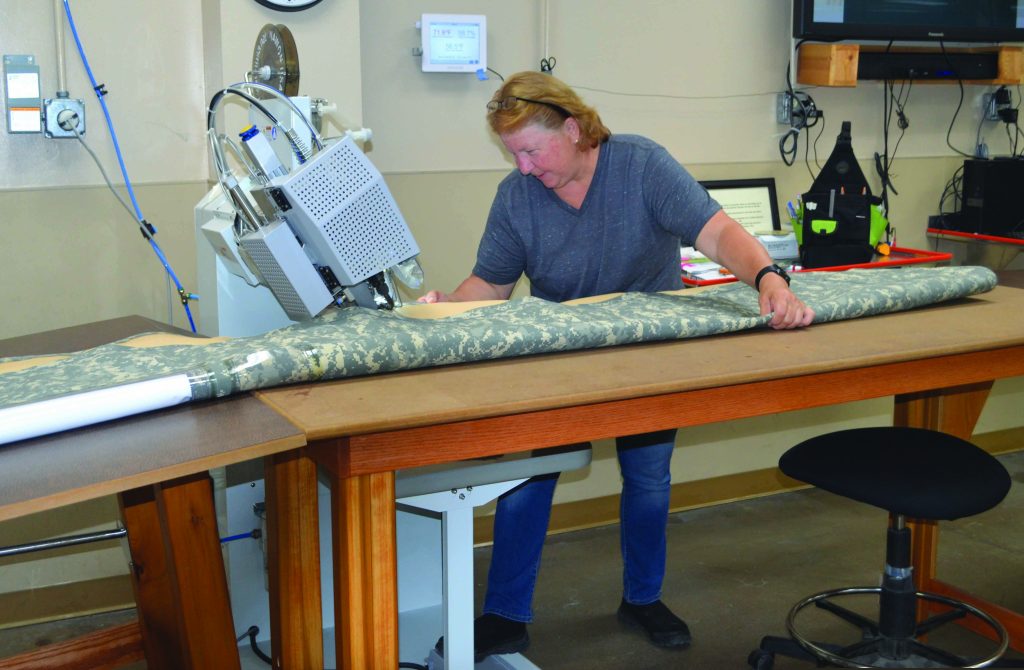
WRAPPING THINGS UP: Julee Johnson, production leader on Pine Bluff Arsenal’s textile line, works on seam sealing a Chemical Protective Patient Wrap. (U.S. Army photo by Rachel Selby, Pine Bluff Arsenal Public Affairs Office)
ROOTS
Pine Bluff reports to Joint Munitions Command, the logistics integrator for life-cycle management of ammunition and is a major subordinate command of Army Materiel Command (AMC).
The genesis for textile manufacturing at Pine Bluff began with recurring issues at the Joint Project Manager for CBRN Protection. At that time, no manufacturing capability existed within the government for the low- and full-rate production CBRN textiles. A few of the chemical and biological-based textile commodities within JPM CBRN Protection’s portfolio had very low demand from the joint services, and the existing manufacturers of those commodities no longer found it financially viable to maintain their production lines.
In order to mitigate perpetual backorder status, the program manager asked whether Pine Bluff would be interested in establishing textile manufacturing capabilities to produce these low-requirement commodities.
In October 2015, the initial groundwork and research began for finding industrial sewing training sources for the arsenal’s workforce, including the University of Arkansas at Pine Bluff’s Department of Human Sciences – Merchandising, Textiles and Design as well as various academic institutes and industrial operations within the state.
The first textile item produced at Pine Bluff was the neck dam, which is a garment made with a carbon-impregnated fabric that provides protection against CBRN contaminants, and issued to wearers of face seal-type masks to increase protection at the mask-garment interface. These items are used with the Joint Protective Aircrew Ensemble, which is a lightweight, CB-protective coverall that resembles a standard flight suit.
In the years following the initial startup, DOD has invested significant time and resources at Pine Bluff to improve the textile manufacturing processes there. JPM CBRN Protection worked with Pine Bluff and experts in textile design and manufacturing from the Naval Clothing and Textiles Research Facility and the U.S. Army Combat Capabilities Development Command Soldier Center (DEVCOM SC) to set up and optimize the facility and add items to Pine Bluff’s production portfolio.
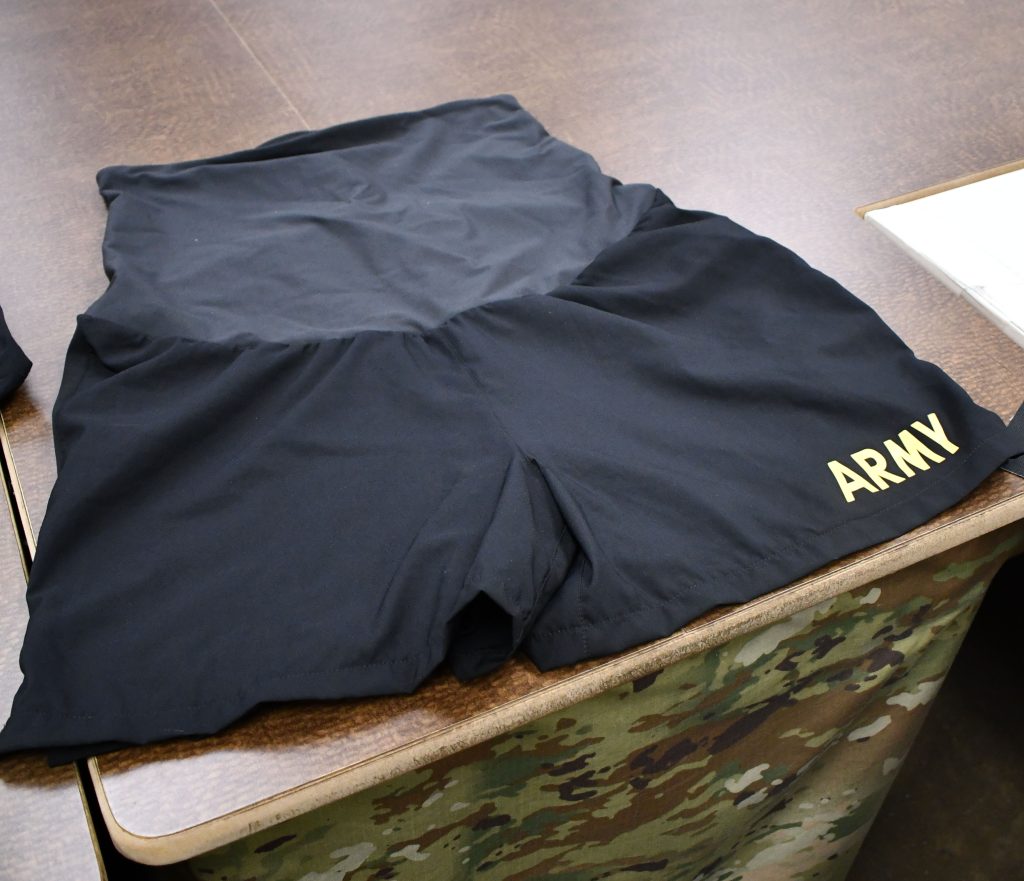
MADE FOR MATERNITY: The Army Physical Fitness Uniform-Maternity is one of the new textile items recently added to Pine Bluff’s portfolio as the result of the PEO Soldier connection. (U.S. Army Photo by Rachel Selby, Pine Bluff Arsenal Public Affairs Office)
| PINE BLUFF STUFF
Some new textile items have recently been added to Pine Bluff’s portfolio as the result of the PEO Soldier connection , including the Improved Ghillie System (IGS) and the Army Physical Fitness Uniform-Maternity. Other CBRN products produced at Pine Bluff include: Integrated Footwear System, a sock/liner system worn under normal combat footwear to provide Chemical and Biological protection to the foot. It is issued as a component of the Joint Service Lightweight Integrated Suit Technology or JSLIST, and the Joint Protective Aircrew Ensemble to meet CB footwear protection requirements of the U.S. Navy and U.S. Marine Corps Aviation and U.S. Special Operations Command, and requires Gore Certification to produce. Cloth face coverings, non-medical personal protective equipment used to provide protection during the COVID-19 pandemic. Approximately 78,000 were produced for AMC’s civilian population. This effort was highlighted in the Winter 2020 edition of Army AL&T. |
NETWORKING
After discovering the article “Thread Level Green” in the September 2020 issue of Army AL&T magazine, Pine Bluff realized the need to open their aperture to include other textiles not part of the CBRN family. Since the infrastructure was already in place, we could simply scale our existing model to include commodities from the Program Executive Office (PEO) for Soldier. Pine Bluff cold-called all the authors of the article and started a dialogue to make sure they were aware of our new capabilities, and thus a new working relationship was born. They were unaware of the work Pine Bluff has done to support CBRN textiles and were eager to learn more about what we could do to support their portfolio.
In April 2022, the Pine Bluff Arsenal was designated by the Department of the Army as a Center for Industrial and Technical Excellence (CITE) for Textile Manufacturing, per 10 U.S.C. 2474. This is the Arsenal’s third CITE designation, having received designations for Chemical and Biological Defense Equipment in 2005, and Smoke Ammunition in 2017. Pine Bluff is the only installation within Joint Munitions Command to have three CITE designations.

UNDER WRAPS: During production, the underside of a Chemical Protective Patient Wrap is displayed. (U.S. Army photo by Hugh Morgan, Pine Bluff Arsenal)
The Army uses CITE designations to recognize the unique capabilities of an Army depot-level activity or military arsenal facility as a mechanism to align workload to the appropriate maintenance and manufacturing facilities.
And as an Army working-capital fund (AWCF) site, Pine Bluff receives effectively zero dollars in appropriated funding. The 13,500 acre “city” is sustained through directly funded production projects. The more meaningful workload we can acquire, the more solvent we are. Since most textiles use similar equipment to produce, so there is little to no startup equipment costs with exploring and establishing new workload.
Current textile manufacturing operations at Pine Bluff occupy approximately 8,000 square feet of an industrial space. The space uses the latest in textile technology, including a Gerber Paragon automated high-ply cutting system using the industrial standard AccuMark pattern design software, advanced seam-sealing equipment and new embroidering equipment with the ability to sew six digital patterns simultaneously. Staffing includes 14 trained operators with nearly 250 years of combined sewing experience, and three trained quality control specialists. This is exactly the type of equipment and processes needed to ensure the design of new textile products are ready for full-rate production.
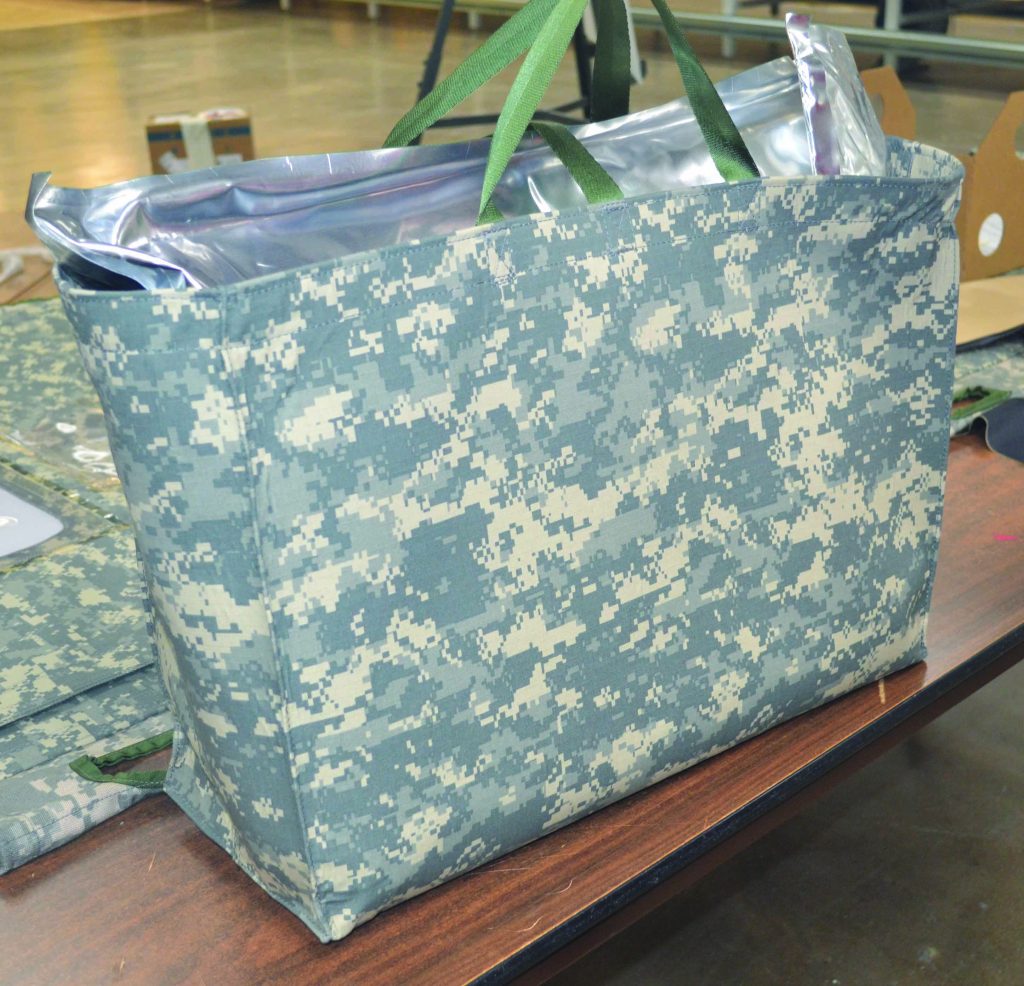
CREATIVE CARRY CASE: This carrying bag, which holds a Chemical Protective Patient Wrap, was created by Pine Bluff Arsenal’s Textile Production crew using scrap materials. (U.S. Army photo by Hugh Morgan, Pine Bluff Arsenal)
Donna Cox, a senior systems engineer in the Product Manager for Soldier Clothing and Individual Equipment/Soldier Survivability (PM SCIE), said a relationship with the Arsenal was established to produce initial field assets for the Improved Ghillie System (IGS). The IGS is a new and improved sniper concealment system that is replacing the legacy Flame Resistant Ghillie Suit, which focused on flame-resistant capabilities at the expense of concealment capabilities, which ultimately did not fulfill the sniper’s needs. As a result, the user redefined and validated new requirements and the team began development of the new IGS.
Pine Bluff “has already provided a mock-up design for PM SCIE and will provide product demonstration models in the coming months. After that, Pine Bluff Arsenal will provide the initial operational quantities of both the IGS kit and the optional items to PM SCIE for fielding to the sniper schools,” she said. The new ghillie suit kit consists of a jacket, hood, leg drape, head drape and jute yarn. The additional optional authorized items include the ghillie hat, skid plate and equipment drape.
According to Cox, the arsenal will also assist in refining the patterns, optimizing manufacturing and documenting the manufacturing process. This information is critical to the completion of the new ghillie suit’s purchasing description and technical data package. DLA Troop Support is the Primary Inventory Control Activity for all consumable products, so once these end-items transition to sustainment, DLA Troop Support is responsible for sourcing and supplying them to the warfighter.
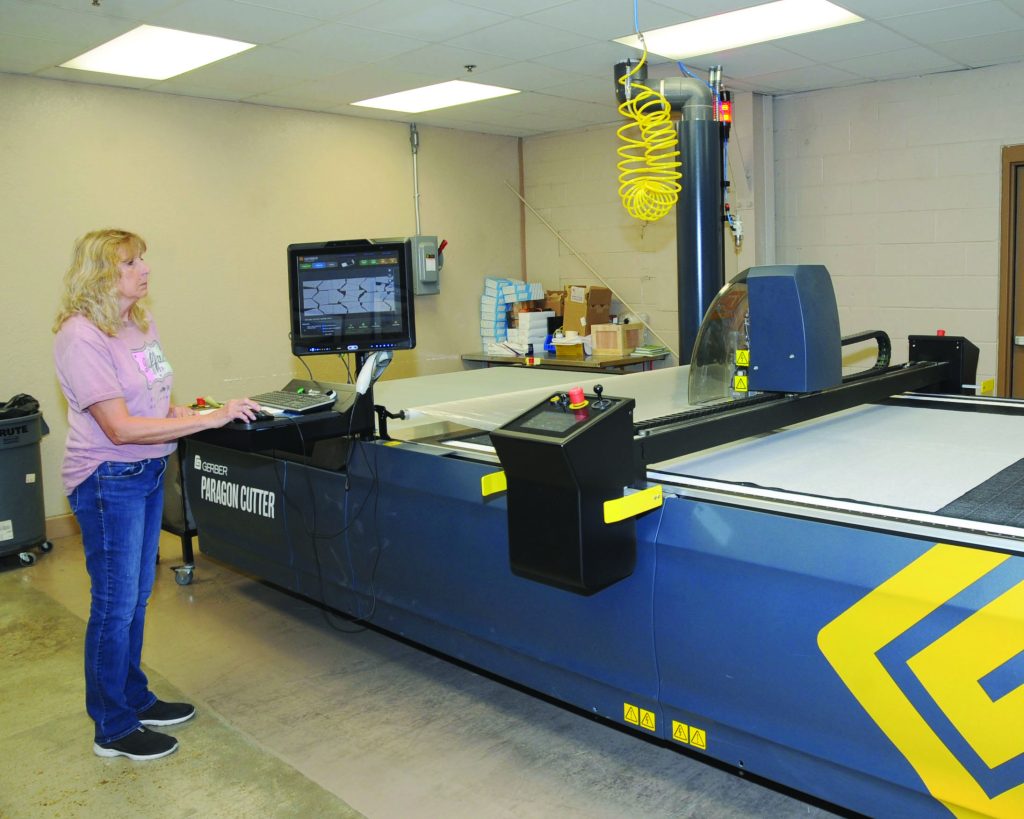
MAKING THE CUT: Pine Bluff Arsenal textile production operator, Tyronza Hudson, is setting up a piece of fabric to be cut at the Gerber Paragon Cutter. (U.S. Army Photo by Hugh Morgan, Pine Bluff Arsenal)
The new ghillie suit is more comfortable, less bulky and weighs fewer than five pounds. It is made of breathable materials and mesh. The system is modular, allowing the user to use some or all system components. This improved system now provides snipers, spotters and scouts with the capability to remain concealed during missions and go undetected when in close proximity of enemy forces.
Additionally, the need for the Army Physical Fitness Uniform-Maternity was identified in June 2020, at the 151st Army Uniform Board. According to Lester Smith, assistant PM with PM SCIE, PM SCIE was directed by the Army Uniform Board to develop a maternity fitness uniform based on the current pattern and look of the unisex Army’s physical fitness uniform. Pine Bluff was asked to codify the evolving designs and to survey the user community for important feedback into various fit factors, such as comfort and maneuverability.
“From 2020 to 2022, PM SCIE and DEVCOM Soldier Center, worked to develop the [Army Physical Fitness Uniform-Maternity] through wear trials with pregnant Soldiers in the Army. Upon completion of the wear trials, an organic, in-house solution for the cut and sew was found at the Pine Bluff Arsenal,” said Smith. “The benefit of having PBA do the cut and sew was two part. Agreements between PBA and SCIE didn’t require in-depth contracts and funding was upfront and transparent.”
Smith said that the new uniform’s “pattern verification is wrapping up and will be moving into production for the maternity pilot program, sponsored by the Defense Logistics Agency.” As feedback is provided from the users, Pine Bluff will work with DEVCOM Soldier Center to modify the patterns and final designs to cement a final design and technical package.

ABOUT FACE: Carol Morris, textile production worker, sews a cloth face covering. (U.S. Army photo by Hugh Morgan, Pine Bluff Arsenal)
|
INDUSTRY PARTNERS In 2019, Pine Bluff entered into a public-private partnership with ReadyOne Industries, an AbilityOne contractor. The agreement focused on the production of the Joint Service Lightweight Integrated Suit Technology, which is a two-piece suit that provides 45 consecutive days’ worth of CBRN protection. The partnership enables ReadyOne to use Pine Bluff as a subcontractor in the production of the suit. ReadyOne has approximately 18 personnel working in a leased facility on the installation. Pine Bluff cuts and delivers the fabric, ReadyOne sews and produces the suit and Pine Bluff performs the final packaging. In March 2022, Pine Bluff signed a memorandum of agreement with DEVCOM Soldier Center. This agreement will ensure Pine Bluff stays engaged with the center’s world-class scientists, engineers and equipment designers to leverage that expertise into the production of all current and future textiles, as well as staying well informed with the new textile products being developed and routed through the acquisition lifecycle. As these products are being developed, understanding how these products will be produced in a full rate manufacturing environment is often misunderstood. Pine Bluff hopes to assist in building manufacturability elements into all stages of product design. |
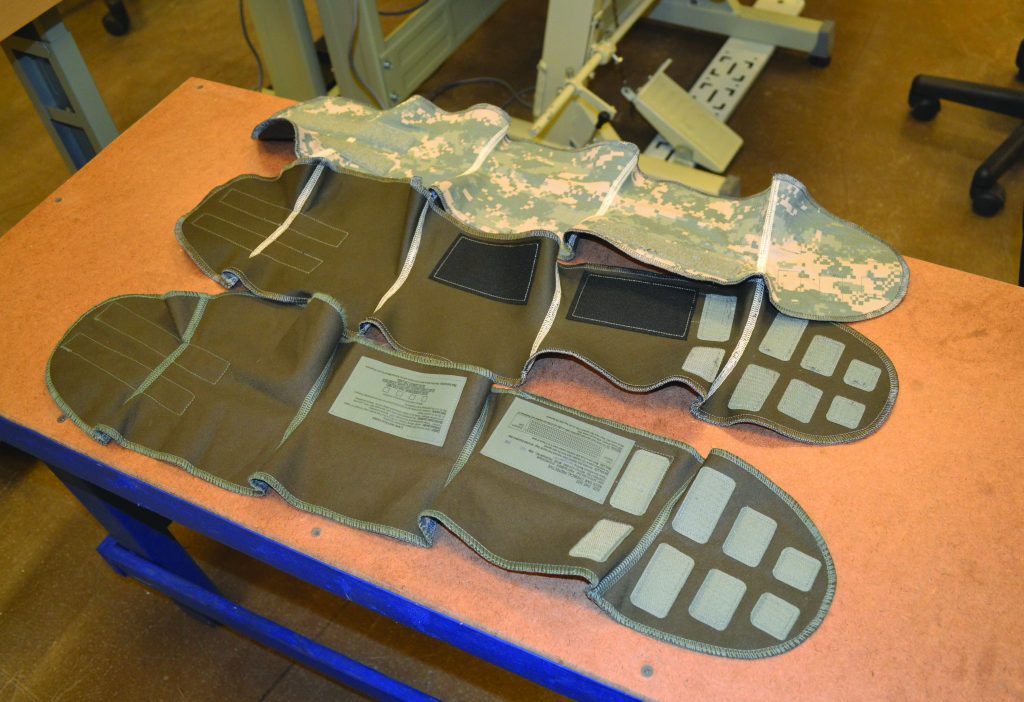
DAM GOOD PROTECTION: The neck dam is a garment made with a carbon-impregnated fabric that provides protection against CBRN contaminants, and issued to wearers of face seal-type masks to increase protection at the mask-garment interface. (U.S. Army photo by Rachel Selby, Pine Bluff Arsenal Public Affairs Office)
CONCLUSION
Pine Bluff is provisioned to retain the critical manufacturing capabilities necessary to meet unique needs of the Army relating to enduring and future warfighter requirements, specifically in the areas of illuminating, infrared and phosphorus munitions as well as chemical biological defense equipment.
The Pine Bluff’s multiple CITE designations will enable the Army to identify, shape and sustain its organic industrial operations as a modern, cost effective and highly responsive enterprise, consistent with the Army’s industrial base strategic plan. The aim of the CITE designation is to maintain the necessary resources and competencies that sustain life-cycle readiness of weapon systems and equipment while also maintaining the capability to surge to meet the demands of future contingency operations. The CITE also allows for the associated installation to serve as recognized leaders in their core competencies throughout DOD.
“We have room to grow, and have identified an additional building that is over four times the size of our current operations,” said Roch Byrne, arsenal deputy to the commander. “With minimal investment, we can continue to bolster domestic textile and PPE manufacturing within the Organic Industrial Base and provide value to our nation’s warfighter.” With AMC’s emphasis on organic industrial base modernization, Pine Bluff will continue to invest and improve textile manufacturing capabilities to meet the demands of the future.
For more information go to: https://www.pba.army.mil/ or contact Justin Lieber at justin.j.lieber.civ@army.mil.
RACHEL C. SELBY is a public affairs specialist at Pine Bluff Arsenal. She is also the editor of the Arsenal Sentinel – PBA’s monthly newsletter. She has been with the arsenal since 2002, first working in the public affairs office as a contractor with General Physics Corporation. In 2013, she received second place in the printed publication category in the U.S. Army Material Command’s David G. Harris competition, and in 2020 she received a first place in the same category. She has an M.A. in journalism from the University of Arkansas at Little Rock and a B.A. in communications with an emphasis in journalism from Drury University.
JUSTIN LIEBER is the division chief of operations & business development at Pine Bluff Arsenal. His office is responsible for the day-to-day operations of the arsenal as well as managing the functions of business development and public private partnerships. His knowledge is focused on commodities associated with chemical and biological defense equipment, including textile manufacturing and collective and individual protection and decontamination. He graduated from the University of Arkansas at Little Rock where he earned a bachelor’s in system engineering, mechanical systems. He is Level III certified in systems engineering, and is an accredited Project Management Professional (PMP) and Agile Certified Practitioner (ACP) from the Project Management Institute (PMI).







